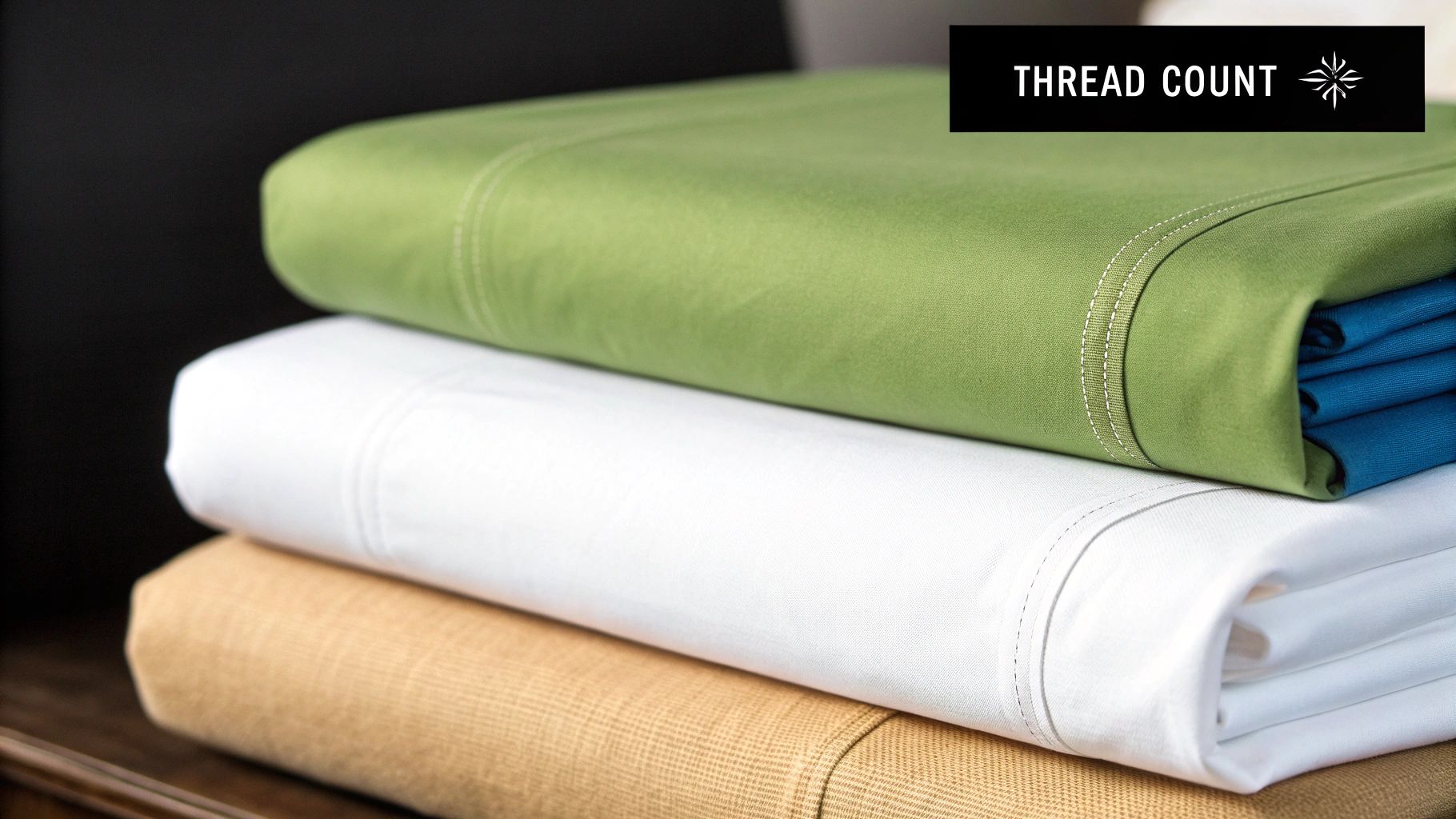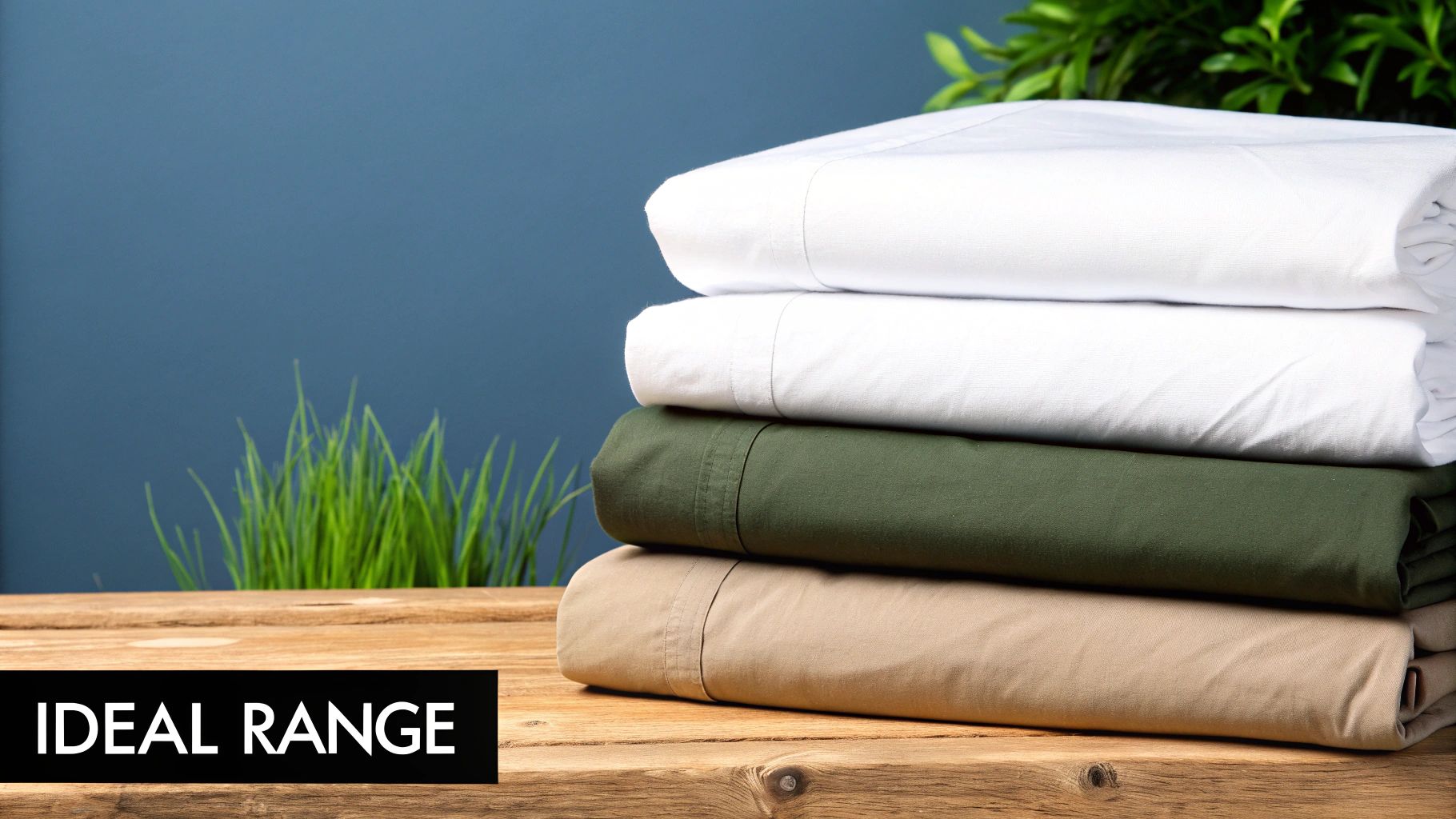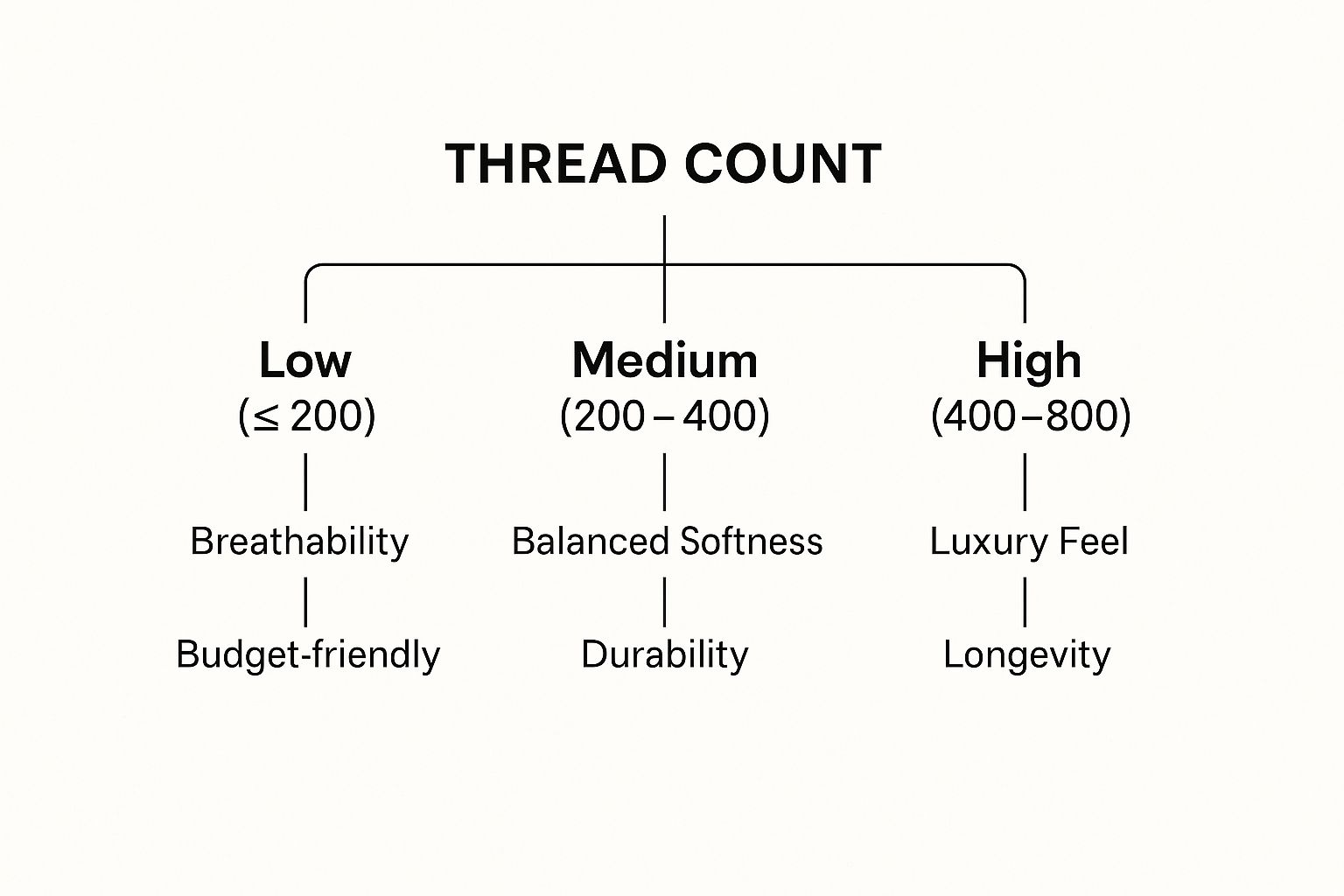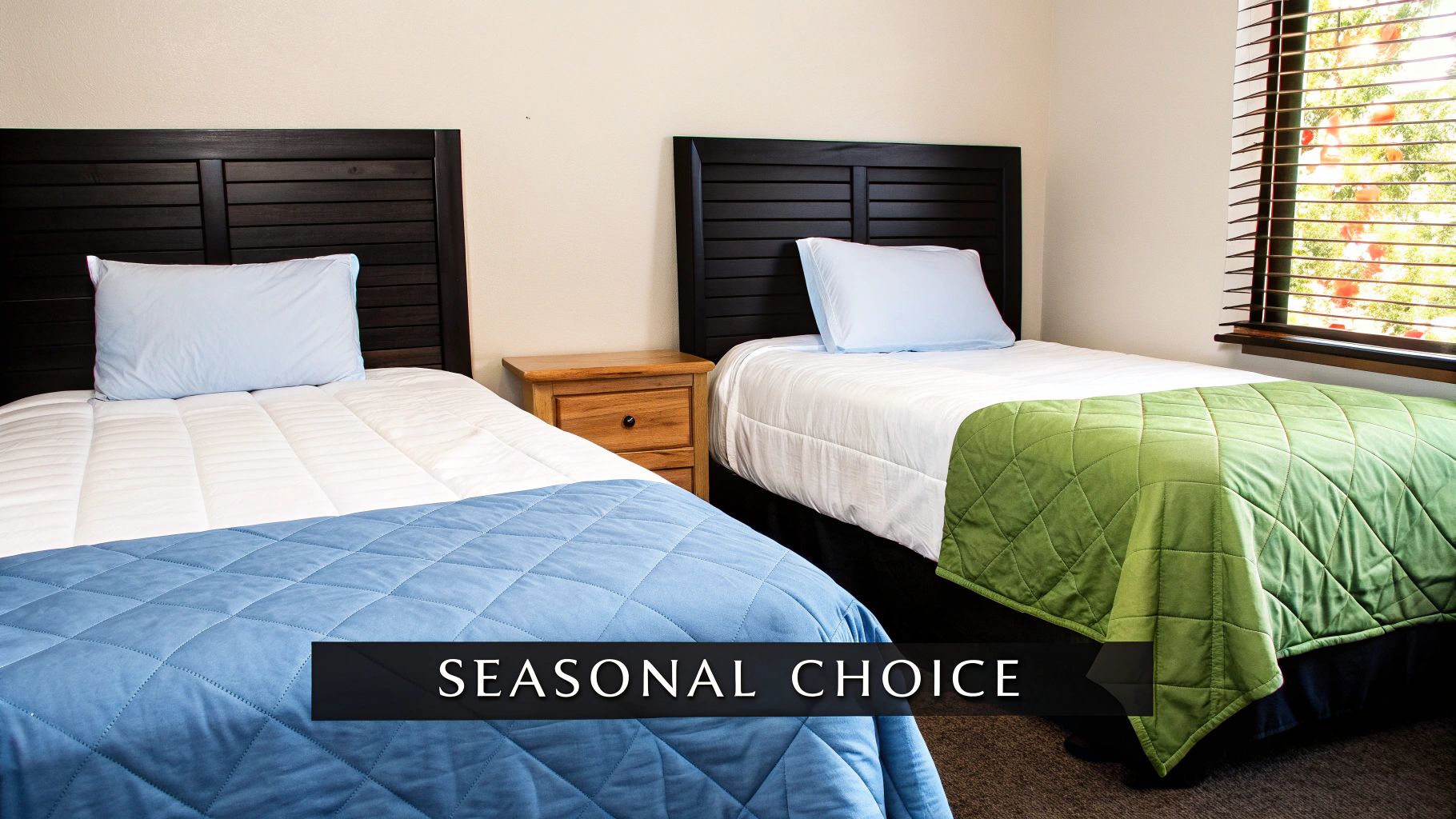Let's be honest, the whole thread count thing can be confusing. It’s easy to think that a higher number automatically means better sheets, but that’s not the whole story. The truth is, the sweet spot for genuinely comfortable, long-lasting sheets usually sits somewhere between 250 and 600. Chasing those sky-high numbers often leads to disappointment, not luxury.
Decoding the Myth of High Thread Count

When you're shopping for new bedding, the numbers game is in full swing. Brands loudly advertise sheets with counts of 1000 or even higher, suggesting that more threads equal more comfort. This is probably one of the biggest and most persistent myths in the world of linen.
At its core, thread count is just a simple measurement: it’s the number of threads woven into one square inch of fabric. And while it does play a role, it's far from the only thing that matters. In fact, an unusually high thread count can sometimes be a warning sign.
What Really Defines Quality Sheets
So, how do manufacturers get those massive numbers? Often, it’s a bit of a marketing trick. They’ll take several thin, lower-quality yarns and twist them together into a single, thicker "multi-ply" thread. This lets them cram more threads into the weave, inflating the count without actually making the sheets any better.
The result? These sheets can feel surprisingly heavy and stiff, and they often don't breathe as well as their lower-count, higher-quality cousins.
The real secret to luxurious bedding isn't about the quantity of threads, but their quality. A 400-thread-count sheet made from beautiful, single-ply, long-staple cotton will feel miles softer and last much longer than a 1000-thread-count sheet woven from weak, multi-ply fibres.
Instead of getting fixated on that one number, a much better approach is to look at the three things that truly create a beautiful sheet:
- Fibre Quality: The type of fibre and its length (like long-staple cotton or pure linen) is the real foundation of great bedding.
- Weave Type: How the threads are woven together—think crisp percale versus silky-smooth sateen—is what determines the final texture and how it feels against your skin.
- Finishing Touches: Special processes done after weaving can add extra softness and improve how well the sheets wear over time.
For some fabrics, like linen, thread count is almost irrelevant. Linen’s quality is measured by its weight (grams per square metre, or GSM), not the number of threads. Learning about the unique benefits of pure linen sheets can really change the way you think about bedding, as it's judged by a completely different, and arguably more honest, standard.
Quick Guide to Ideal Thread Counts by Fabric
To make it easier, here’s a quick rundown of the thread count ranges you should look for in New Zealand for some of the most popular types of sheets. This will help you find that perfect balance of comfort, breathability, and durability.
| Fabric Type | Ideal Thread Count Range (NZ Standard) | Primary Feel |
|---|---|---|
| Egyptian Cotton | 400-700 | Supremely soft, smooth, and durable |
| Pima/Supima Cotton | 300-600 | Very soft, silky, and resistant to pilling |
| Cotton Percale | 200-400 | Light, crisp, and cool; like a classic hotel sheet |
| Cotton Sateen | 300-600 | Silky-smooth, lustrous, and slightly warmer |
| Bamboo | 300-500 | Exceptionally soft, breathable, and moisture-wicking |
| Linen | 80-150 (Measured in GSM) | Naturally textured, breathable, and gets softer with every wash |
Remember, this table is a guide. Your personal preference is what matters most, but these ranges are a fantastic starting point for finding high-quality sheets that will feel amazing for years to come.
Decoding Thread Count and Cutting Through the Marketing Hype

When you see "thread count" plastered across bedding packaging, what are you actually looking at? Think of it like weaving a tiny, intricate basket. The process for creating fabric is much the same, just on a microscopic level.
At its core, thread count is simply the total number of threads woven into a specific patch of fabric. It’s a tally of the vertical threads (the warp) and the horizontal threads (the weft) combined. A bigger number just means those threads are packed together more tightly.
But this is where the story gets complicated, and where clever marketing often starts to cloud the picture. A sky-high number on the label doesn’t automatically promise a better night's sleep.
The Problem with Inflated Numbers
So, how do some brands get away with claiming thread counts of 1,000 or even more? The secret is a well-known manufacturing shortcut that uses multi-ply yarns.
Instead of starting with a single, strong, high-quality fibre, some manufacturers twist several thinner, weaker threads together to form one yarn. They then count each of those low-grade individual strands in the final number.
This practice can easily double or triple the advertised thread count. A sheet marketed as having a 1,000-thread-count could really be a 500-thread-count sheet made with a cheap two-ply yarn. The number looks impressive, but the final product is often heavy, coarse, and nowhere near as breathable as you'd hope.
The truth is, a beautifully crafted 400-thread-count sheet made from premium, single-ply yarn will almost always feel softer, last longer, and breathe better than a 1,000-thread-count sheet made from weaker, multi-ply threads. It’s a classic case of quality over quantity.
How to See Past the Gimmicks
To avoid falling for these tactics, you need to shift your focus from the number itself to the quality of the materials. The best thread count for sheets is one that's honest and built on a foundation of superior fibres.
Think of it this way: would you rather have a wall built from 100 solid, perfectly formed bricks, or one made from 200 crumbly, poorly made ones? The exact same logic applies to your bedding.
It’s also crucial to know how these numbers are measured locally. In New Zealand, thread count is usually calculated over a 10cm square, not a square inch. Because of this, a 250-thread-count is a great starting point for quality materials like bamboo. For premium cotton, a count around 500 often hits the luxury sweet spot, giving you that perfect blend of softness and strength without feeling too heavy or stiff. You can learn more about how to interpret these figures for top-quality sheets in New Zealand.
Once you understand this, you can look right past the big, flashy numbers on the packaging. Instead of being swayed by a high count, you can start asking the right questions about the yarn itself—because that’s where true comfort and lasting quality really come from.
Why Fibre Quality and Weave Outweigh Thread Count
Let's think about cooking for a moment. You could have the most amazing recipe in the world, but if you're using subpar ingredients, the final dish is never going to be spectacular. Bedding works in exactly the same way. The material of the threads is the real star of the show, making the best thread count for sheets a bit of a distraction if you don't start with excellent fibre quality.
The difference between premium and standard materials is night and day. It’s like comparing a cheap, scratchy wool jumper to a beautifully soft merino one. In the world of cotton, that difference comes down to the length of the individual fibres, something we call the staple.
The Importance of Fibre Staple
Cottons like Egyptian or Pima are known as long-staple or extra-long-staple cottons. This simply means their individual fibres are much longer than those of standard Upland cotton. So, why does that matter for your sheets?
- Strength and Durability: Longer fibres can be spun into a much stronger and finer yarn. With fewer tiny ends sticking out, the resulting fabric is far less prone to pilling or tearing, meaning it will last beautifully for years.
- Supreme Softness: Fewer fibre ends also means the fabric feels incredibly smooth and silky against your skin. In fact, sheets made from long-staple cotton tend to get even softer with every wash.
A sheet made from premium long-staple cotton with a modest thread count will feel far more luxurious and easily outlast one with a sky-high count made from weak, short-staple fibres. The quality of the raw material is the foundation of true comfort.
This infographic gives a good general breakdown of what to expect from different thread count ranges, showing why balance is so important.

As you can see, the sweet spot often sits somewhere in the middle. This is where you get a beautiful balance of softness and durability without making the fabric so dense that it can't breathe.
How Weave Creates a Unique Feel
Once you've got that high-quality yarn, the next piece of the puzzle is the weave—the specific pattern used to interlace the horizontal and vertical threads. You can take the exact same premium cotton and, depending on how you weave it, create two completely different sleep experiences.
The two most common weaves you’ll come across are percale and sateen.
Think about this: a 300-thread-count percale sheet and a 300-thread-count sateen sheet are made from the same fibre and have the identical count. Yet, they offer completely distinct textures and sleep environments. This really drives home that the weave is just as crucial as the number on the package.
Percale Weave: A Cool, Crisp Choice
Percale is woven with a straightforward one-thread-over, one-thread-under grid pattern. It's a simple, tight weave that creates a fabric that feels:
- Crisp and Cool: It has that light, airy feel you associate with a classic, high-end hotel sheet.
- Breathable: The structure allows air to circulate freely, making it a fantastic choice for hot sleepers or those warm New Zealand summers.
- Matte Finish: Percale doesn't have the shine of sateen, giving it a more modern, understated look.
Sateen Weave: A Silky, Smooth Indulgence
Sateen uses a different technique, usually a three or four-threads-over, one-thread-under pattern. By exposing more of the thread's surface, you get a fabric that is:
- Silky and Smooth: It has a noticeable lustre and a buttery-soft feel that drapes beautifully.
- Warmer to the Touch: Because the weave is a bit denser, it's not quite as breathable as percale. This makes it a cosier choice for cooler nights.
- Wrinkle-Resistant: Sateen is naturally less prone to wrinkling than its crisp percale cousin.
This isn't just industry talk; it's backed up by what we see here at home. While you can find sheets in New Zealand with thread counts from 180 to over 1,000, experts from local consumer reports confirm that a higher number is no guarantee of quality. They remind us that factors like the fibre, ply, and weave type have a much bigger impact on how a sheet feels and lasts, urging shoppers to look beyond the marketing numbers.
Your Guide to Choosing the Perfect Sheets
Alright, now that you’re armed with a better understanding of fibres and weaves, we can get down to the fun part: choosing your perfect bedding. This is where we turn theory into practice, creating a simple roadmap to find sheets that feel just right for you. Forget getting bogged down by a sea of numbers; let's focus on what truly matters—the feel.
The best thread count for sheets isn’t a single magic number. It's the one that delivers the specific texture you love, whether that’s the crisp, cool snap of a boutique hotel bed or the silky, liquid drape of pure luxury. It all comes down to finding that sweet spot where the material, weave, and thread count align with your personal sleep heaven.
For Lovers of Crisp Hotel Sheets
Do you dream of slipping into a bed that feels like a five-star getaway? If so, your perfect match is a Percale weave. This is that classic one-thread-over, one-thread-under construction that creates a light, breathable fabric with a distinctive crispness that feels wonderfully cool against the skin. It’s an absolute winner for hot sleepers or anyone navigating New Zealand's warmer months.
For percale, look for a thread count in the 200-400 range. This is the ideal zone, providing a beautiful balance of softness and airflow without feeling heavy or stiff. A set of high-quality, long-staple cotton percale sheets in this range feels incredibly refreshing from night one and, believe it or not, gets even better with every wash.
For Those Who Crave Silky Luxury
If your idea of heaven is being cocooned in buttery-soft, smooth fabric, then a Sateen weave is calling your name. Sateen has a unique structure—typically one-under, three-or-four-over—that exposes more of the thread's surface. This is what gives it that signature silk-like feel and a beautiful, subtle lustre.
It’s slightly warmer and has a heavier drape than percale, making it a wonderfully cosy option for your bed. For sateen, the sweet spot for thread count sits between 300 and 600. This range delivers that gorgeous silky softness and great durability without sacrificing too much breathability. It’s pure indulgence and an amazing first step in creating a truly cozy home.
To make the choice a little easier, here’s a quick look at how these two popular weaves stack up against each other.
Percale vs Sateen Weave Comparison
This table offers a direct comparison of the two most popular cotton weaves, helping you choose based on what you value most in your bedding.
| Feature | Percale Weave | Sateen Weave |
|---|---|---|
| Feel | Crisp, cool, and breathable | Silky, smooth, and buttery |
| Look | Matte, clean finish | Subtle, elegant lustre |
| Best For | Hot sleepers, warm climates | Those seeking warmth and luxury |
| Durability | Very durable, gets softer over time | Durable, but more prone to snagging |
| Wrinkling | More prone to wrinkling | Naturally wrinkle-resistant |
Ultimately, whether you lean towards the refreshing crispness of percale or the opulent softness of sateen is a matter of personal preference. There's no right or wrong answer, only what feels best for your sleep.
Recommendations for Other Materials
Of course, cotton isn't the only player in the game! Other materials bring their own unique qualities to the table, each with its own ideal measurement.
- Bamboo: Famous for its exceptional softness and moisture-wicking properties, bamboo is a brilliant choice for sensitive skin. Aim for a thread count between 250-400 to get the best of its silky feel and natural breathability.
- Linen: For that relaxed, effortlessly chic, lived-in aesthetic, nothing beats pure linen. Linen quality isn't measured by thread count but by weight, specifically grams per square metre (GSM). A good quality linen sheet will typically fall between 120-180 GSM.
Remember, these are trusted guidelines, not strict rules. The ultimate goal is to find what feels best for you. Personal preference is king, and now you have the tools to make an informed choice.
Turning your bed into the perfect retreat is a deeply personal journey. It’s about more than just sheets; it’s about curating a space that helps you rest and recharge. For more inspiration on embracing those slow, mindful moments, you might enjoy our thoughts on how to make the most of a lazy Sunday at home.
How to Protect Your Bedding Investment

You’ve done the hard work, navigated the myths around thread count, and finally found the perfect sheets. But that's only the first step. To make sure your beautiful new bedding stays soft, strong, and vibrant for years, you need to know how to look after it. It’s the small, consistent habits that really protect your investment in the long run.
Interestingly, some of that protection starts before the sheets even reach your home. Top-tier manufacturers often use special finishing processes to give their fabrics an edge. One of the best is mercerisation, a treatment that strengthens cotton fibres, helps them absorb dye more evenly for a richer colour, and gives the finished fabric a beautiful, subtle lustre. This process essentially preps the material for a long and luxurious life.
Once those sheets are on your bed, it's over to you. The goal is simple: gentle care. Being mindful of how you treat the fabric preserves its natural integrity and wards off common problems like pilling or premature wear.
Essential Care Tips for Longevity
To keep that 'brand-new' feeling, how you wash and dry your linens is everything. Harsh treatments can quickly break down even the highest quality cotton or linen.
-
Choose a Mild Detergent: Aggressive chemicals and optical brighteners are tough on delicate fibres, eventually making them brittle. Stick with a gentle, pH-neutral liquid detergent to be safe.
-
Wash in Cool or Warm Water: High heat is the enemy of natural fibres. It can cause shrinkage and weaken the threads, so always opt for a cool or warm cycle.
-
Go Easy on the Dryer: Tumble dry your sheets on a low-heat setting. The trick is to pull them out while they’re still slightly damp. Over-drying essentially 'bakes' the fibres, leaving them feeling scratchy and looking faded.
If you remember just one thing, make it this: avoid high heat at all costs. In both the washing machine and the dryer, excessive temperatures break down the very fibres that make your sheets feel so luxurious in the first place.
And while your sheets are getting all this love, don't forget about the foundation of your bed. The day you strip the sheets for a wash is the perfect opportunity to give your mattress a bit of attention. Knowing some general mattress cleaning techniques can extend its life and hygiene, ensuring your entire bed remains the clean, comfortable sanctuary it's meant to be.
Your Top Thread Count Questions, Answered
Even after getting to grips with the basics, a few common questions always seem to surface right when you're ready to buy. Let's tackle them head-on, so you can feel completely confident in your choice.
Are 1000 Thread Count Sheets Really Better?
Almost never. A sky-high thread count like 1000 is usually more of a marketing gimmick than a genuine measure of quality. To hit these impressive-sounding numbers, manufacturers often resort to twisting multiple shorter, weaker fibres together into a 'multi-ply' yarn.
What you end up with is a sheet that sounds luxurious but often feels heavy, stiff, and traps heat. It simply can’t compete with the soft, breathable feel of a sheet made with superior single-ply cotton. Always remember: the quality is in the fibre, not the figure.
What’s the Best Thread Count for Hot Sleepers?
If you're someone who tends to run hot at night, your magic number is a thread count between 200 and 400, especially in a percale weave. This combination is the perfect recipe for a cool and comfortable sleep.
The straightforward, one-over-one-under grid of a percale weave allows for fantastic airflow, creating a light, breathable fabric. Paired with a moderate thread count, this delivers that crisp, cool-to-the-touch sensation that hot sleepers crave, helping to prevent you from overheating during the night.
How Do I Spot Genuinely High-Quality Sheets?
The smartest way to find top-tier bedding is to look right past the thread count and focus on the language used on the packaging or in the product description. Certain words are far better indicators of a soft, durable, and truly luxurious sheet.
Keep an eye out for these hallmarks of quality:
- Single-Ply: This tells you each yarn is made from a single, strong strand, not a collection of weaker threads twisted together.
- Long-Staple Cotton: This means the cotton fibres themselves are longer and smoother, which results in a much stronger and softer fabric.
- Pima or Egyptian Cotton: These are premium varieties of long-staple cotton, celebrated for their exceptional feel and durability.
For a more detailed look, our guide on buying the best cotton sheets online in NZ has even more practical tips to help you make a brilliant choice.
At The Foxes Den, we’re firm believers that true luxury comes from exceptional materials and meticulous craftsmanship. Explore our curated collection of premium linen and cotton bedding to find the perfect foundation for a beautiful night's sleep. Discover your new favourite sheets at https://www.thefoxesden.co.nz.
Article created using Outrank


